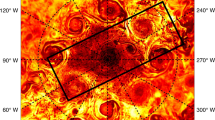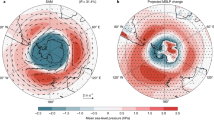Abstract
Jupiter's dominant large-scale weather patterns (dimensions ∼10,000 km) are zonal jets and long-lived ovals. The jets have been flowing east and west at constant speeds of up to 180 m s-1 for over 100 years1,2,3. These jets receive energy from small-scale eddies, which pump1 eastward momentum into the eastward jets and westward momentum into the westward jets. This momentum transfer was predicted by numerical models4 before it was observed on Jupiter1. The large ovals roll between the jets in an anticyclonic direction5—clockwise in the northern hemisphere and counterclockwise in the southern hemisphere—where they regularly assimilate small anticyclonic eddies5,6. But from where the eddies receive their energy has been an open question. Here we argue that the eddies, which ultimately drive both the jets and the ovals, receive their energy from moist convection. This hypothesis is consistent with observations of jovian lightning7,8,9, which is an indicator of moist convection10,11. It also explains the anticyclonic rotation and poleward drift of the eddies5, and suggests patterns of upwelling and downwelling that resemble the patterns of large-scale axisymmetric overturning in the Earth's atmosphere.
This is a preview of subscription content, access via your institution
Access options
Subscribe to this journal
Receive 51 print issues and online access
$199.00 per year
only $3.90 per issue
Buy this article
- Purchase on Springer Link
- Instant access to full article PDF
Prices may be subject to local taxes which are calculated during checkout

Similar content being viewed by others
References
Ingersoll, A. P. et al. Interaction of eddies and mean zonal flow on Jupiter as inferred from Voyager 1 and 2 images. J. Geophys. Res. 86, 8733–8743 (1981).
Limaye, S. S. Jupiter: New estimates of the mean zonal flow at the cloud level. Icarus 65, 335–352 (1986).
Vasavada, A. R. et al. Galileo imaging of Jupiter's atmosphere: The Great Red Spot, equatorial region, and White Ovals. Icarus 135, 265–275 (1998).
Williams, G. P. Planetary circulations: Barotropic representation of jovian and terrestrial turbulence. J. Atmos. Sci. 35, 1399–1426 (1978).
Mac Low, M. -M. & Ingersoll, A. P. Merging of vortices in the atmosphere of Jupiter: An analysis of Voyager images. Icarus 65, 353–369 (1986).
Dowling, T. E. & Ingersoll, A. P. Jupiter's Great Red Spot as a shallow water system. J. Atmos. Sci. 46, 3256–3278 (1989).
Little, B. et al. Galileo images of lightning on Jupiter. Icarus 142, 306–323 (1999).
Banfield, D et al. Jupiter's cloud structure from Galileo imaging. Icarus 135, 230–250 (1998).
Gierasch, P. J. et al. Observation of moist convection in Jupiter's atmosphere. Nature 403, 628–630 (2000).
Gibbard, S., Levy, E. H. & Lunine, J. I. Generation of lightning in Jupiter's water cloud. Nature 378, 592–595 (1995).
Yair, Y., Levin, Z. & Tzivion, S. Lightning generation in a jovian thundercloud: Results from an axisymmetric numerical cloud model. Icarus 115, 421–434 (1995).
Niemann, H. B. et al. The composition of the jovian atmosphere as determined by the Galileo probe mass spectrometer. J. Geophys. Res. 103, 22831–22845 (1998).
Folkner, W. M., Woo, R. & Nandi, S. Ammonia abundance in Jupiter's atmosphere derived from the attenuation of the Galileo probe's radio signal. J. Geophys. Res. 103, 22847–22855 (1998).
Gierasch, P. J., Conrath, B. J. & Magalhães, J. A. Zonal mean properties of Jupiter's upper troposphere from Voyager infrared observations. Icarus 67, 456–483 (1986).
West, R. A., Strobel, D. F., & Tomasko, M. G. Clouds, aerosols, and photochemistry in the jovian atmosphere. Icarus 65, 161–217 (1986).
Ingersoll, A. P. in Neptune and Triton (ed. Cruikshank, D. P.) 613–682 (Univ. Arizona, Tucson, 1995).
Holton, J. R. An Introduction to Dynamic Meteorology, 3rd edn (Academic, San Diego, 1992).
Gill, A. E. Atmosphere-Ocean Dynamics (Academic, San Diego, 1982).
Rhines, P. B. Waves and turbulence on a beta-plane. J. Fluid Mech. 69, 417–443 (1975).
Maltrud, M. E. & Vallis, G. K. Energy spectra and coherent structures in forced two-dimensional and beta-plane turbulence. J. Fluid Mech. 228, 321–342 (1991).
Panetta, R. L. Zonal jets in wide baroclinically unstable regions: Persistence and scale selection. J. Atmos. Sci. 50, 2073–2106 (1993).
Cho, J. Y. -K. & Polvani, L. M. The morphogenesis of bands and zonal winds in the atmospheres on the giant outer planets. Science 273, 335–337 (1996).
Huang, H. -P. & Robinson, W. A. Two-dimensional turbulence and persistent zonal jets in a global barotropic model. J. Atmos. Sci. 55, 611–632 (1998).
Hunt, G. E., Müller, J. -P. & Gee, P. Convective growth rates of equatorial features in the jovian atmosphere. Nature 295, 491–494 (1982).
McWilliams, J. C. & Flierl, G. R. On the evolution of isolated, nonlinear vortices. J. Phys. Oceanogr. 9, 1155–1182 (1979).
Achterberg, R. K. & Ingersoll, A. P. Numerical simulation of baroclinic jovian vortices. J. Atmos. Sci. 51, 541–562 (1994).
LeBeau, R. -P. & Dowling, T. E. EPIC simulations of time-dependent, three-dimensional vortices with application to Neptune's Great Dark Spot. Icarus 132, 239–265 (1999).
Acknowledgements
We thank A. Simon for useful suggestions. This research was supported by the NASA Galileo Project and the NASA Planetary Atmospheres Program.
Author information
Authors and Affiliations
Corresponding author
Rights and permissions
About this article
Cite this article
Ingersoll, A., Gierasch, P., Banfield, D. et al. Moist convection as an energy source for the large-scale motions in Jupiter's atmosphere. Nature 403, 630–632 (2000). https://doi.org/10.1038/35001021
Received:
Accepted:
Issue Date:
DOI: https://doi.org/10.1038/35001021
This article is cited by
-
Atmospheric Science Questions for a Uranian Probe
Space Science Reviews (2024)
-
Jupiter Science Enabled by ESA’s Jupiter Icy Moons Explorer
Space Science Reviews (2023)
-
Moist convection drives an upscale energy transfer at Jovian high latitudes
Nature Physics (2022)
-
The turbulent dynamics of Jupiter’s and Saturn’s weather layers: order out of chaos?
Geoscience Letters (2020)
-
Ice Giant Circulation Patterns: Implications for Atmospheric Probes
Space Science Reviews (2020)
Comments
By submitting a comment you agree to abide by our Terms and Community Guidelines. If you find something abusive or that does not comply with our terms or guidelines please flag it as inappropriate.



